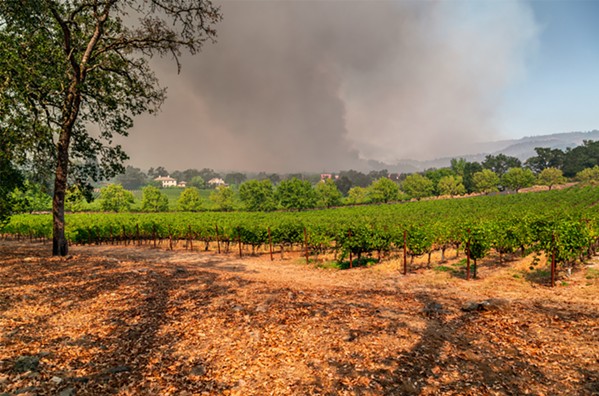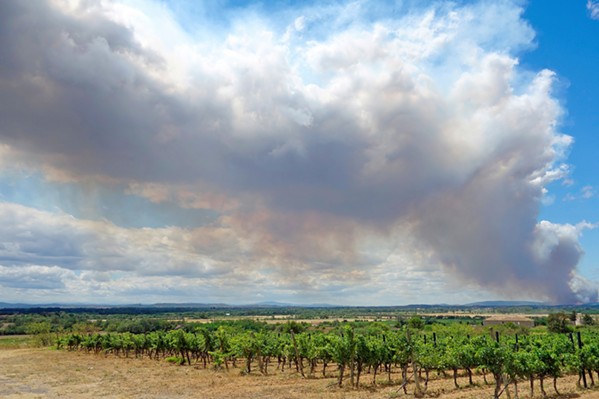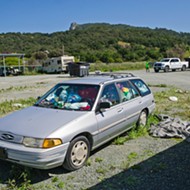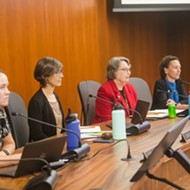Smoky fields: As wildfire seasons grow more intense, West Coast elected officials want to help vineyards and wineries deal with the impact
By Bulbul Rajagopal[{
"name": "Newsletter Promo",
"id": "NewsletterPromo",
"class": "inlineCenter",
"insertPoint": "4",
"component": "15264767",
"requiredCountToDisplay": "0"
},{
"name": "Ad - Medium Rectangle CC01 - 300x250",
"id": "AdMediumRectangleCC01300x250",
"class": "inlineCenter",
"insertPoint": "8",
"component": "2963441",
"requiredCountToDisplay": "12"
},{
"name": "Ad - Medium Rectangle LC01 - 300x250",
"id": "AdMediumRectangleCC01300x250",
"class": "inlineCenter",
"insertPoint": "18",
"component": "2963441",
"requiredCountToDisplay": "22"
},{
"name": "Ad - Medium Rectangle LC09 - 300x250",
"id": "AdMediumRectangleLC09300x250",
"class": "inlineCenter",
"insertPoint": "28",
"component": "3252660",
"requiredCountToDisplay": "32"
}]
Three West Coast senators introduced two pieces of legislation that aim to understand one nascent problem: the impact of wildfire smoke on wine grapes.
On June 22, Sen. Alex Padilla (D-California) brought forward the Smoke Exposure Research Act, co-led by Sen. Jeff Merkley (D-Oregon), and the Crop Insurance for Wine Grapes Act, co-led by Sen. Patty Murray (D-Washington) and U.S. Rep. Dan Newhouse (R-Washington).
Despite the flurry of wildfires that have ravaged wine countries in California, Oregon, and Washington since 2020, the impact of the resulting smoke on wine grapes and the extent of its damage are relatively foggy. In California alone, a little more than 9,900 wildfires burned 4.3 million acres in 2020, according to a UC Davis wildfire season report. That total is more than twice the previous record number of acres burned in the state. The 2020 wildfires cost California wine grape growers and wineries $3.7 billion from immediate fire-related causes and subsequent loss in future sales because of unharvested grapes exposed to the smoke.
"We haven't really been able to figure out exactly how much smoke needs to be present in one area for it to really affect grapes, so we have a little bit of work to do on the research side," Natalie Collins, the president of the California Association of Winegrape Growers, told New Times on July 6.
The association calls itself the only statewide organization that specializes in wine grape grower issues. It's governed by 27 growers elected to serve on its board, and according to Collins, the group has been involved with Padilla's office since 2022 to discuss the legislation.
"We pitched the idea of selective buy-up coverage or an endorsement for wildfires, and we based this off something already in existence on the East Coast," she said.
Collins is referring to the second piece of Padilla's proposed legislation that pertains to crop insurance. The wine grape association drew inspiration from the Hurricane Insurance Protection-Wind Index. It covers 70 different crops and caters to counties in the vicinity of the Gulf of Mexico and the Atlantic and Hawaii. Collins said that the hurricane protection plan allows its subscribers to "buy up" to a higher level of insurance once the wind index meets a certain threshold. The association applied similar logic to the crop insurance blueprint for Padilla's legislation.
"Growers would have their normal crop insurance, and on top of that they can buy up coverage or get an endorsement for wildfire smoke," Collins said. "What this legislation is really doing is having the risk management agency do more research and see what that policy would look like."
Researchers committed to the bills have viticulture expertise, and some of them belong to UC Davis, Washington State University, and Oregon State University—the three land-grant universities that will coordinate with the U.S. Department of Agriculture's Agricultural Research Service if the legislation passes.
Green-lighting the Smoke Exposure Research Act would commit $32.5 million to the researchers over a five-year period to ensure the sustainability of the wine industry and study the effects of climate change on the industry.
"Congress has provided $5 million to the USDA to study smoke taint since fiscal year 2020," the bill's summary reads. "However, this research has never been formally authorized and instead relies upon annual appropriations and report language each year."
The danger of wildfires on wine grapes is a new California problem. Wine grapes are usually harvested between August and October—a period that falls right inside the state's May through October fire season. Though, according to Frontline Wildfire Defense, some experts suggest that wildfires are now a year-long issue because of climate change. Wildfire smoke's damage to wine grapes wasn't on the public or political radar as much until 2020.
"We just didn't know the great impact of wildfires here in California," Collins said. "There have been other countries like Australia who have experienced wildfires in the past and they've been doing research. But here, 2020 was the first big wildfire hit where we discovered the impact wildfires have on grapes, and in turn, the finished wine."
One of those discoveries is smoke taint: Smoke compounds from wildfires enter the thin skins of exposed grapes, resulting in an ashy taste that's especially prominent once the affected grapes are fermented to make wine.
Wildfire smoke is measured in the air using the air quality index (AQI). While preliminary research focused on AQI, Collins said that other factors are also thrown in the mix when assessing smoke impact and studying smoke taint prevention.
"It could be on how long the AQI or smoke is at that level, is the wind blowing and is it moving the smoke through, how low is the smoke sitting on the grape?" Collins said. "There are so many varietals of grapes. Some have thicker skins than others, some mature at a different time period."
Smoke taint became a problem for SLO County's grapes in 2020, California Association of Winegrape Growers Co-Vice Chair Gregg Hibbits who represents SLO, told New Times.
"There were grapes that were rejected in SLO County that probably shouldn't have been based on how much smoke taint they had, but the reason for the rejection was unquestionably that wineries believed that there were smoke compounds in the grapes," he said.
According to SLO County's 2021 Annual Crop Report, the region produced 133,281 tons of wine grapes in 2020. The next year, it produced 166,473 tons, with an increase of $63 million over the 2020 value.
Hibbits hopes that the crop insurance part of the legislation will buttress financial protection for local wine grape growers dealing with smoke taint losses. He added that the problem with crop insurance in its current form is that it's specifically designed to only pay growers back for crops that are not harvested.
"The hard thing with smoke taint is if you're not sure whether the grapes are impacted and you pick them, at that point the winery says the wine is no good," Hibbits said. "There isn't a good process for crop insurance to deal with that specific situation."
Collins agreed. She told New Times that the West Coast faced such large-scale wine grape damage because growers couldn't test their produce fast enough during the 2020 wildfire season. The short window for picking coupled with a series of fires compelled growers to leave the fruit on the vine for much longer.
"You leave on the vine too much longer and if it's hot out, they're gonna continue to ripen and get higher sugars," Collins said. "The longer you leave them on the vine being exposed to smoke, there is a higher probability of grapes getting damaged."
She added that the main goal of the research is to limit who really needs to test their wine grapes. Typically, wineries visit the vineyards they want to purchase grapes from and conduct on-site tests, checking for sugar levels measured in Brix, greenness, and maturity, among other requirements. Before 2020, in a scenario without the impact of wildfire smoke, it took 24 hours to test the grapes and get the results. Collins thinks tests are quicker now, but during the harvest period in 2020 growers experienced weeks-long testing delays.
"The next step in research is getting the tools in the vineyard so that growers are able to test on their own—getting market ready products so you can test grapes and wine in the vineyard," Collins said. Δ
Reach Staff Writer Bulbul Rajagopal at [email protected].
Latest in News
Comments
Showing 1-1 of 1
Readers also liked…
-

Coast Unified teachers upset over new position's salary and qualifications
Oct 20, 2022 -

SLO police identify alleged driver who hit and killed couple
Dec 22, 2022 -

When the levee breaks: Oceano residents, county officials walk a tightrope of regulations to manage Arroyo Grande Creek, which some say led to the levee's failure in January
May 18, 2023










